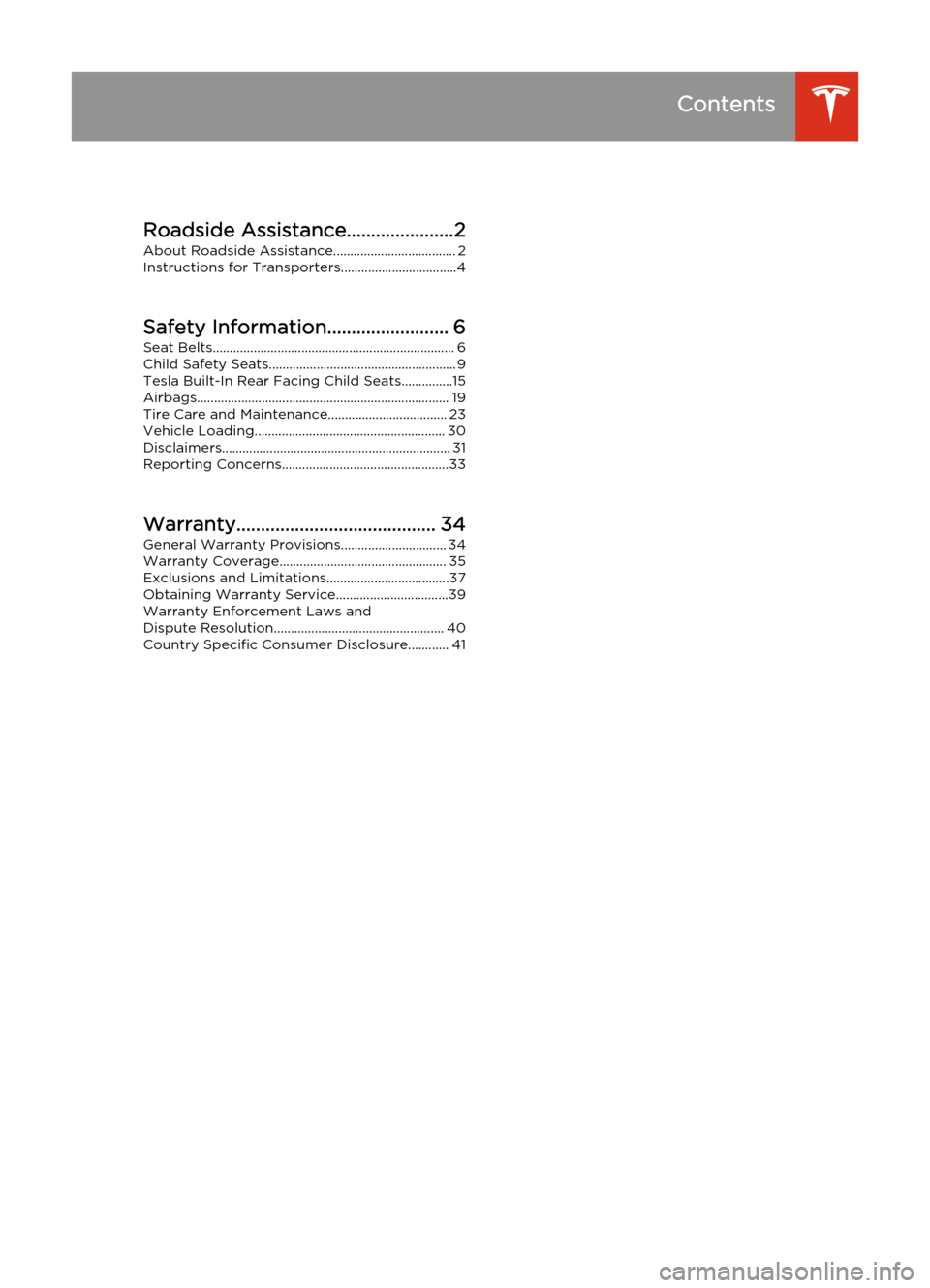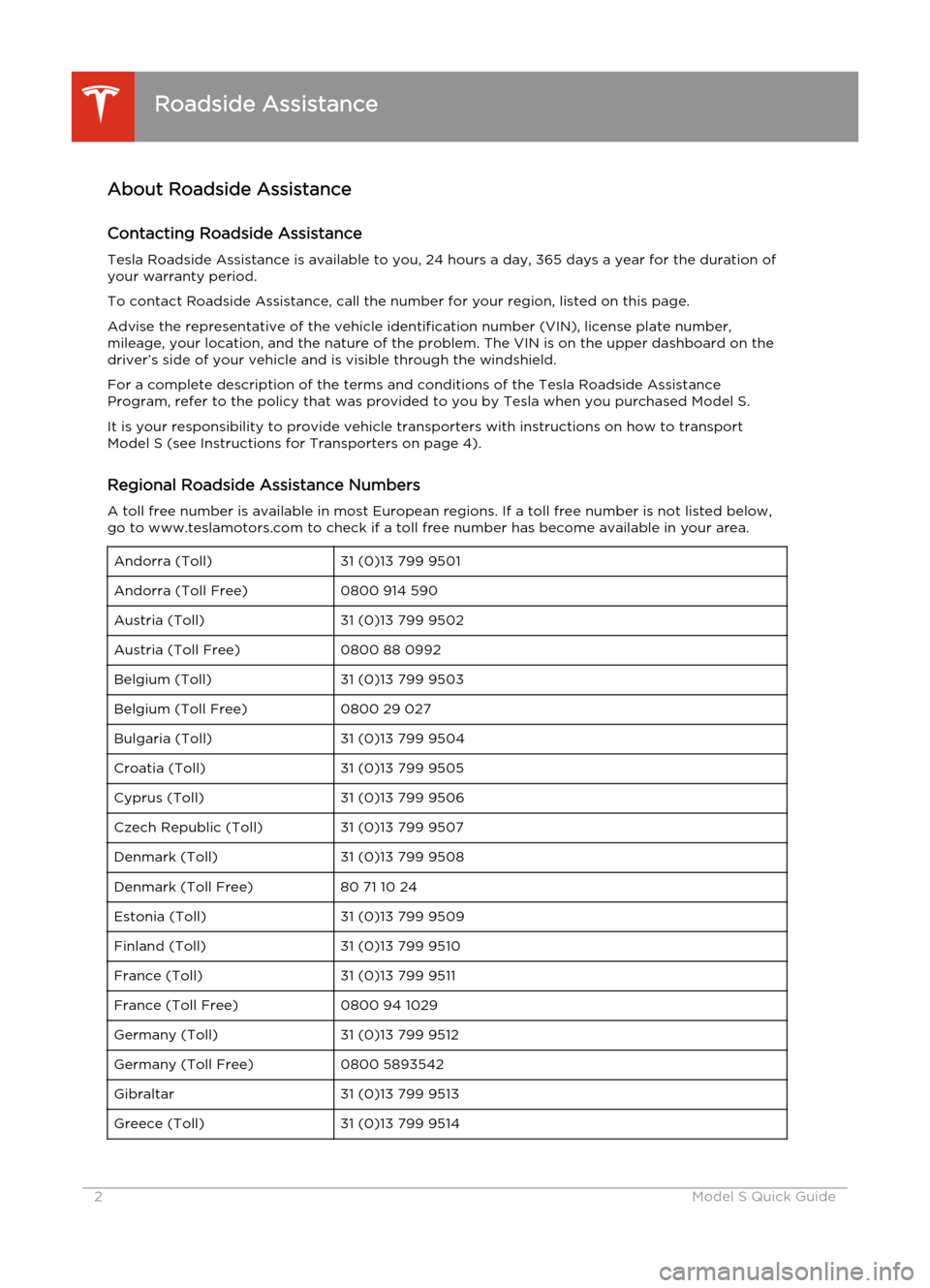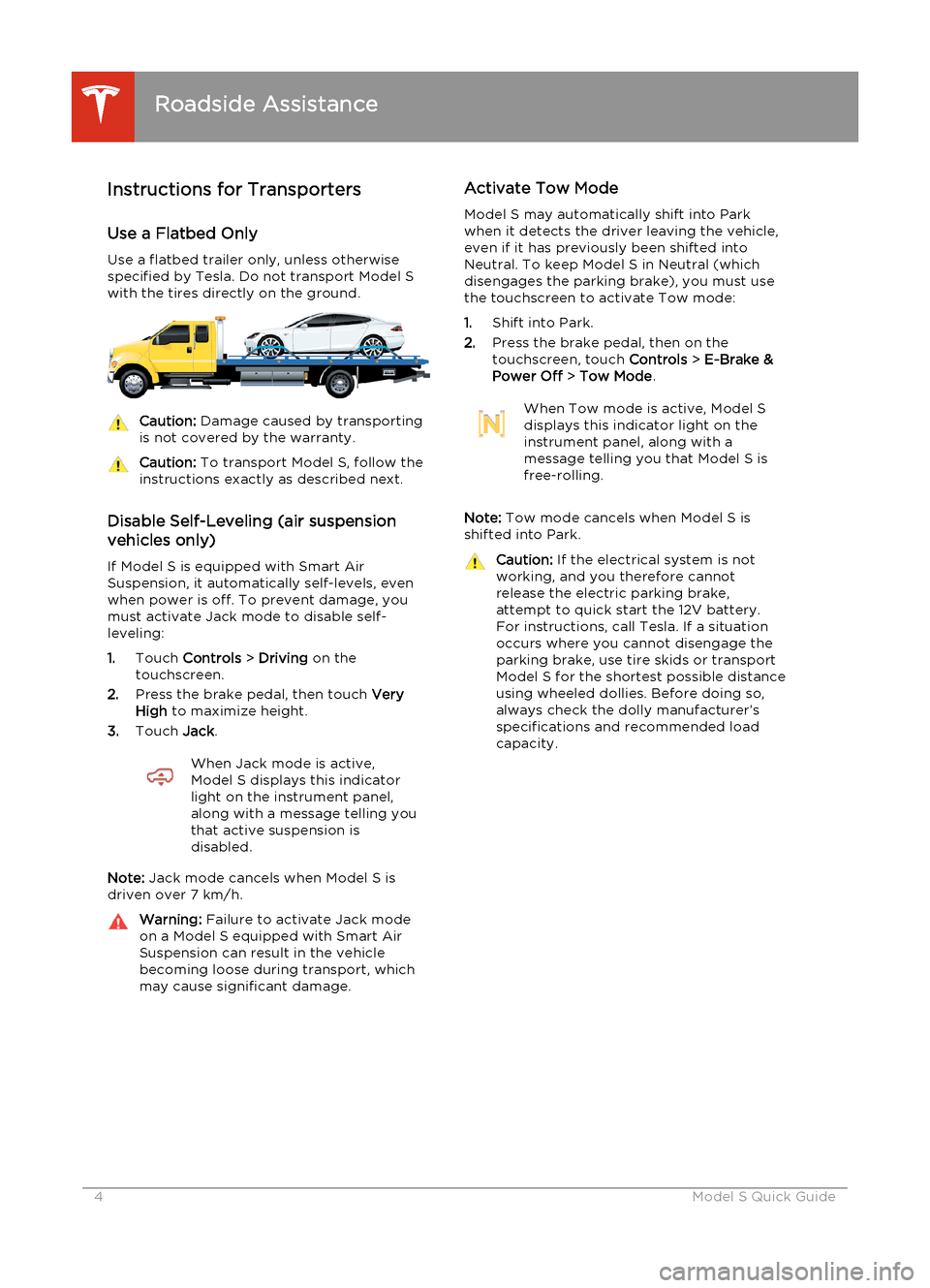ECO mode TESLA MODEL S 2014 Quick Guide (Europe)
[x] Cancel search | Manufacturer: TESLA, Model Year: 2014, Model line: MODEL S, Model: TESLA MODEL S 2014Pages: 52, PDF Size: 2.24 MB
Page 3 of 52

Roadside Assistance......................2About Roadside Assistance.................................... 2
Contacting Roadside Assistance 2Regional Roadside Assistance Numbers 2
Instructions for Transporters..................................4
Use a Flatbed Only 4Disable Self-Leveling (air suspension vehicles only) 4Activate Tow Mode 4Connect the Tow Chain 5Pull Onto the Trailer and Secure the Wheels 5
Safety Information......................... 6Seat Belts....................................................................... 6
Wearing Seat Belts 6Wearing Seat Belts When Pregnant 6Seat Belt Pre-tensioners 7Testing Seat Belts 7Seat Belt Warnings 8
Child Safety Seats....................................................... 9
Guidelines for Seating Children 9Choosing a Child Safety Seat 9Seating Larger Children 11Installing Child Safety Seats 11Installing Seat Belt Retained Child Seats 11Installing ISOFIXChild Seats 12Attaching Upper Tether Straps 13Testing a Child Safety Seat 13Warnings - Child Safety Seats 14
Tesla Built-In Rear Facing Child Seats...............15
Usage Restrictions 15Opening 15Folding 16Seating a Child 17Warnings - Tesla Child Seats 18
Airbags.......................................................................... 19
Location of Airbags 19How the Airbags Work 20Types of Airbags 20Disabling the Passenger Front Airbag 21Inflation Effects 22Airbag Warning Indicator 22Airbag Warnings 22
Tire Care and Maintenance................................... 23
Maintaining Tire Pressures 23Inspecting and Maintaining Tires 24Replacing Tires and Wheels 25Using Tire Chains 26Tire Pressure Monitoring 26Understanding Tire Markings 28
Vehicle Loading........................................................ 30
Load Capacity Labeling 30Calculating Load Limits 31Towing a Trailer 31
Disclaimers................................................................... 31
Vehicle Telematics/Data Recorders 31Quality Control 32
Reporting Concerns.................................................33
Contacting Tesla 33
Warranty......................................... 34General Warranty Provisions............................... 34
Who is the Warrantor? 34What Vehicles are Covered? 34Multiple Warranty Conditions 34Limitations and Disclaimers 34Your Rights Under Local Law 35Ownership Transfer 35Who Can Enforce this New Vehicle Limited Warranty? 35When Does the Warranty Period Begin and End? 35
Warranty Coverage................................................. 35
Basic Vehicle Limited Warranty 36Supplemental Restraint System Limited Warranty 36Battery Limited Warranty 36
Exclusions and Limitations....................................37
Warranty limitations 37Additional limitations and exclusions 37Voided warranty 38Damages 38
Obtaining Warranty Service.................................39
Payment of Tax for Repairs 39Reasonable Time for Repairs 39Modifications and Waivers 40
Warranty Enforcement Laws and
Dispute Resolution.................................................. 40 Country Specific Consumer Disclosure............ 41
Bulgaria 41France 42Italy 42Norway 43Poland 44San Marino 44Contents
Page 4 of 52

About Roadside AssistanceContacting Roadside Assistance
Tesla Roadside Assistance is available to you, 24 hours a day, 365 days a year for the duration of your warranty period.
To contact Roadside Assistance, call the number for your region, listed on this page.
Advise the representative of the vehicle identification number (VIN), license plate number,
mileage, your location, and the nature of the problem. The VIN is on the upper dashboard on the
driver’s side of your vehicle and is visible through the windshield.
For a complete description of the terms and conditions of the Tesla Roadside Assistance
Program, refer to the policy that was provided to you by Tesla when you purchased Model S.
It is your responsibility to provide vehicle transporters with instructions on how to transport
Model S (see Instructions for Transporters on page 4).
Regional Roadside Assistance Numbers
A toll free number is available in most European regions. If a toll free number is not listed below,
go to www.teslamotors.com to check if a toll free number has become available in your area.Andorra (Toll)31 (0)13 799 9501Andorra (Toll Free)0800 914 590Austria (Toll)31 (0)13 799 9502Austria (Toll Free)0800 88 0992Belgium (Toll)31 (0)13 799 9503Belgium (Toll Free)0800 29 027Bulgaria (Toll)31 (0)13 799 9504Croatia (Toll)31 (0)13 799 9505Cyprus (Toll)31 (0)13 799 9506Czech Republic (Toll)31 (0)13 799 9507Denmark (Toll)31 (0)13 799 9508Denmark (Toll Free)80 71 10 24Estonia (Toll)31 (0)13 799 9509Finland (Toll)31 (0)13 799 9510France (Toll)31 (0)13 799 9511France (Toll Free)0800 94 1029Germany (Toll)31 (0)13 799 9512Germany (Toll Free)0800 5893542Gibraltar31 (0)13 799 9513Greece (Toll)31 (0)13 799 9514
Roadside Assistance
2Model S Quick Guide
Page 6 of 52

Instructions for Transporters
Use a Flatbed Only
Use a flatbed trailer only, unless otherwise specified by Tesla. Do not transport Model Swith the tires directly on the ground.Caution: Damage caused by transporting
is not covered by the warranty.Caution: To transport Model S, follow the
instructions exactly as described next.
Disable Self-Leveling (air suspension
vehicles only)
If Model S is equipped with Smart Air Suspension, it automatically self-levels, evenwhen power is off. To prevent damage, youmust activate Jack mode to disable self-
leveling:
1. Touch Controls > Driving on the
touchscreen.
2. Press the brake pedal, then touch Very
High to maximize height.
3. Touch Jack.
When Jack mode is active,
Model S displays this indicator
light on the instrument panel,
along with a message telling you
that active suspension is
disabled.
Note: Jack mode cancels when Model S is
driven over 7 km/h.
Warning: Failure to activate Jack mode
on a Model S equipped with Smart Air
Suspension can result in the vehicle becoming loose during transport, which
may cause significant damage.Activate Tow Mode
Model S may automatically shift into Park
when it detects the driver leaving the vehicle, even if it has previously been shifted intoNeutral. To keep Model S in Neutral (which
disengages the parking brake), you must use
the touchscreen to activate Tow mode:
1. Shift into Park.
2. Press the brake pedal, then on the
touchscreen, touch Controls > E-Brake &
Power Off > Tow Mode .When Tow mode is active, Model S
displays this indicator light on the
instrument panel, along with a
message telling you that Model S is
free-rolling.
Note: Tow mode cancels when Model S is
shifted into Park.
Caution: If the electrical system is not
working, and you therefore cannot
release the electric parking brake,
attempt to quick start the 12V battery.
For instructions, call Tesla. If a situation
occurs where you cannot disengage the
parking brake, use tire skids or transport
Model S for the shortest possible distance
using wheeled dollies. Before doing so,
always check the dolly manufacturer’s specifications and recommended load
capacity.
Roadside Assistance
4Model S Quick Guide
Page 10 of 52

Seat Belt WarningsWarning: Seat belts should be worn by all
occupants at all times, even if driving for a very short distance. Failure to do so
increases the risk of injury or death if an
accident occurs.Warning: Secure small children in a
suitable child safety seat (see Choosing a Child Safety Seat on page 9). Always
follow the child safety seat
manufacturer's instructions when
installing.Warning: Ensure that all seat belts are
worn correctly. An improperly worn seat
belt increases the risk of injury or death if
an accident occurs.Warning: Do not wear seat belts over
hard, fragile or sharp items in clothing, such as pens, keys, eyeglasses, etc. The
pressure from the seat belt on such items can cause injury.Warning: Seat belts should not be worn
with any part of the strap twisted.Warning: Each seat belt assembly must
be used by one occupant only. It is
dangerous to put a seat belt around a
child being carried on an occupant’s lap.Warning: Seat belts that have been worn
in an accident must be inspected or
replaced by Tesla, even if damage to the
assembly is not obvious.Warning: Seat belts that show signs of
wear (such as fraying), or have been cut or damaged in any way, must be replacedby Tesla.Warning: Avoid contaminating a seat
belt’s components with any chemicals,
liquids, grit, dirt or cleaning products. If a
seat belt fails to retract or latch into the
buckle, it must be replaced immediately.
Contact Tesla.Warning: Do not make modifications or
additions that can prevent a seat belt
mechanism from taking up slack, or that
can prevent a seat belt from being
adjusted to remove slack. A slack belt
greatly reduces occupant protection.Warning: Do not make modifications that
can interfere with the operation of a seat
belt, or that can cause a seat belt to
become inoperable.Warning: When seat belts are not in use,
they should be fully retracted and not hanging loose. If a seat belt does not fullyretract, contact Tesla.
Safety Information
8Model S Quick Guide
Page 12 of 52

ISOFIX Installed Child Restraints
Mass GroupSize ClassFixture
Rear
Outboard ISOFIX
PositionRear Centre
ISOFIX
Position*Group 0up to 10 kgER1ILIL
Group 0+up to 13 kg
ER1IL A, CILDR2ILAILCR3ILA, BIL
Group 19 - 18 kg
DR2ILILCR3ILILBF2IUF, IL BIUFB1F2xIUF, ILB, DIUFAF3IUF, IL DIUFIL: Suitable for any semi-universal child restraint (any rear or forward facing restraint with
support leg)
IUF: Suitable for any universal child restraint (forward facing with tether)
A Recommendation: Takata Mini E4 04443717
B Recommendation: Takata Midi E4 04444204
C Recommendation: Maxi-cosi Cabriofix/Easyfix E4 04443517
D Recommendation: Maxi-cosi Pearl/familyfix E4 043908
*The rear center ISOFIX seating position is not available on all vehicles.
Note: If the combined weight of the child and the child safety seat is over 29 kg, Tesla
recommends attaching the safety seat using the seat belt and upper tether strap. In addition to
safety, this has the added benefit of ensuring the seat belt reminder does not stay lit. Always
follow the seat belt manufacturer’s instructions when installing child safety seats.
Safety Information
10Model S Quick Guide
Page 14 of 52

Installing ISOFIX Child Seats
Lower ISOFIX anchor positions are provided
in the second-row seats and are located
between the seat's back rest and rear cushion. The exact location of each anchor is identifiedby a child safety seat identification button,illustrated below. The button is located on the
seat back, directly above its associated
anchor. Some Model S vehicles have two
ISOFIX seating positions (outboard seating
positions only) whereas others have three.
On vehicles with the center ISOFIX position,
you can install two ISOFIX seats adjacent to
each other only if you install one of the seats on the right (passenger side) and the other in
the center, as illustrated below. To seat three children, use a seat belt retained seat in the
center position.
On vehicles without the center ISOFIX
position, install ISOFIX seats in the outboard
seating positions only and always use a seat
belt retained seat in the center position.
Safety Information
12Model S Quick Guide
Page 15 of 52

To install a ISOFIX retained child safety seat,
slide the safety seat latches onto the anchor
bars until they click into place. Carefully read
and follow the instructions provided by the child safety seat manufacturer.
Once installed, test the security of the
installation before seating a child. Attempt to
twist the child safety seat from side to side and try to pull it away from the seat, then
check that the anchors are still securely in place.
Attaching Upper Tether Straps
If an upper tether strap is provided, attach its
hook to the anchor point located on the back
of the rear seats. Always position the strap so
that it runs over the center of the Model S
head support, except in cases where you are
installing a ISOFIX retained child safety seat in
the center position—in this case, run the strap
over the left hand side of the head support, as
shown. Tighten according to the child safety
seat manufacturer’s instructions.
Note: To prevent the strap from moving from
side to side, the top of the head support
deforms.
Testing a Child Safety Seat
Before seating a child, always make sure the child safety seat is not loose:
1. Hold the child safety seat by the belt path
and try to slide the safety seat from side
to side and front to back.
2. If the seat moves more than 2.5 cm, it is
too loose. Tighten the belt or reconnect the ISOFIX retained child safety seat.
3. If you are unable to reduce slack, try a
different seat location or try another child
safety seat.
Safety Information
Safety Information13
Page 17 of 52

Tesla Built-In Rear Facing Child
Seats
Usage Restrictions
The optional Tesla built-in rear facing child
seats are child restraint systems and are approved to United Nations ECE Regulation
R44.04 standards for use by children in Mass
Groups II and III, weighing 15 - 36 kg. These
seats must only be used for children who are
between 3 and 12 years old, and 98 -
135 cm tall.
Always ensure the top of the child’s head cannot contact the vehicle and that the child
is seated comfortably with the seat belts
positioned and latched correctly. The child’s
pelvis must be held securely in place by the
lap belt. Follow all instructions provided and
do not use supplemental child safety seats in
these seats.
Note: Whenever a child is seated in the Tesla
built-in rear facing child seats, it is
recommended that you set the climate control
system to draw outside air into Model S
instead of recirculating the air. This draws
more air into the rear seating areas.
Opening 1. Remove the cover from the trunk floor
and pull the strap to lift the seat assembly upward.2. Push the seat assembly into position.
3.Undo the Velcro strap.
4.Pull the handle to release the head
supports from the seat back, then pull the
head supports toward you to unfold them.
5. Raise the seat back to the upright position
and push until it locks into position.
Safety Information
Safety Information15
Page 19 of 52

Seating a Child
The Tesla built-in rear facing child seats are
child restraint systems and are approved to
United Nations ECE Regulation R44.04
standards for use by children in Mass Groups II
and III, weighing 15 - 36 kg. These seats must
only be used for children who are between 3 and 12 years old, and 98 - 135 cm tall.
Always ensure the top of the child’s head
cannot contact the vehicle and that the child
is seated comfortably with the seat belts positioned and latched correctly. The child’spelvis must be held securely in place by thelap belt. Follow all instructions provided anddo not use supplemental child safety seats in
these seats.
Note: Whenever a child is seated in the Tesla
built-in rear facing child seats, it is
recommended that you set the climate control
system to draw outside air into Model S instead of recirculating the air. This draws
more air into the rear seating areas.
1. Position the child in the seat with arms
through the loops of the seat belts.
2. Connect the two halves of the seat belt
tongue.
3. Insert the seat belt tongue latch into the
buckle and ensure it is securely fastened.
4. Adjust the shoulder belts so they run over
the top of the child’s shoulders and away
from the face.
5. Adjust the length of the buckle to ensure
the lower straps sit low on the child’s
pelvis. The child’s pelvis must be held
firmly in place.
6. Pull the lower straps until the child is
securely held in the seat.
7. Slide the shoulder clips into place to
ensure the upper portion of the belts
remain positioned over the child’s
shoulders.
To release, press the button on the buckle,
and separate the two halves of the seat
restraint.
Safety Information
Safety Information17
Page 24 of 52

Inflation EffectsWhen airbags inflate, a fine powder is
released. This powder can irritate the skin and should be thoroughly flushed from the eyes
and from any cuts or abrasions.
After inflation, the airbags deflate to provide a
gradual cushioning effect for the occupants and to ensure the driver’s forward vision is notobscured.
If airbags have inflated, or if your vehicle has been in an accident, always have the airbags,seat belt pre-tensioners and any associated
components checked and, if necessary,
replaced by Tesla.
In a collision, in addition to the airbags
inflating:
• Doors unlock and the door handles extend.
• Hazard warning lights turn on.
• Interior lights turn on.
• High voltage is disabled.
To restore Battery power, use the touchscreen to manually power off Model S, then press thebrake to power it back on again.
Airbag Warning IndicatorThe airbag indicator on the
instrument panel remains lit if the
airbag system is malfunctioning. The
only time this indicator should light
up is briefly when Model S first starts
up, in which case it turns off within a few seconds. If it remains lit, contact
Tesla immediately and do not drive.Airbag WarningsWarning: All occupants, including the
driver, should always wear their seat
belts, whether or not an airbag is also
provided at their seating position, to
minimize the risk of severe injury or death
in the event of a collision.Warning: Front seat occupants should
not place their arms over the airbag
module, as an inflating bag can cause
fractures or other injuries.Warning: Do not use seat covers on
Model S. Doing so could restrict
deployment of the side air bags if an
accident occurs. It can also reduce the
accuracy of the occupant detection
system.Warning: Airbags inflate with
considerable speed and force, which can
cause injury. To limit injuries, ensure that
occupants are wearing seat belts and are
correctly seated, with the seat positioned
as far back as possible.Warning: Do not use a child safety seat or
seat young children on a seat with an operational airbag in front of it. Doing socan cause injury or death if the airbaginflates.Warning: To ensure correct inflation of
the side airbags, maintain an
unobstructed gap between an occupant’s
torso and the side of Model S.Warning: Passengers should not lean their
heads against the doors. Doing so can cause injury if a curtain airbag inflates.Warning: Do not allow passengers to
obstruct the operation of an airbag by
placing feet, knees or any other part of the body on or near an airbag.Warning: Do not attach or place objects
on or near the front airbags, the side of
the front seats, the headliner at the side of the vehicle, or any other airbag coverthat could interfere with inflation of an
airbag. Objects can cause serious injury if the vehicle is in a collision severe enoughto cause the airbag to inflate.Warning: Following inflation, some airbag
components are hot. Do not touch until
they have cooled.
Safety Information
22Model S Quick Guide